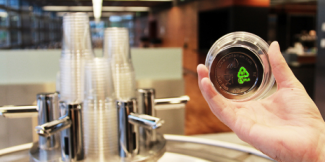Dec 8 2014
An eco-friendly, cost-effective process to produce lactic acid from glycerol has been developed by research groups at ETH Zurich. Glycerol is a waste by-product that is obtained during production of biodiesel.
 The use of biodegradable plastic packaging made of polylactic acid (PLA) is spreading. Since this year, PLA cups are available also in the ETH canteens. (Photo: Bo Cheng / ETH Zurich)
The use of biodegradable plastic packaging made of polylactic acid (PLA) is spreading. Since this year, PLA cups are available also in the ETH canteens. (Photo: Bo Cheng / ETH Zurich)
Plastics are widely used for many applications. However, most types of plastic are not biodegradable. Polylactic acid (PLA) is a biodegradable plastic that is produced from renewable resources. It is currently used in packaging applications, such as for disposable cups and bags, and demand for PLA is expected to grow to one megaton per annum by 2020.
Glycerol contains ash and methanol residues that make it unsuitable for use in the pharmaceutical and chemical industries. Furthermore, it cannot be used as an energy source as it does not burn well. Until now, no effective use has been found for glycerol.
Currently, sugar fermentation is being used for production of lactic acid. In the new method developed at ETH Zurich, glycerol is converted to dihydroxyacetone, and a heterogeneous catalyst is used to convert this intermediate into lactic acid.
This heterogeneous catalyst, designed by Professor Pérez-Ramírez’s Advanced Catalysis Engineering group consists of a zeolite, which is a microporous mineral. Its structure promotes chemical reactions within its pores.
The catalyst has a long life span and demonstrates high reactivity. The researchers performed the life cycle assessment of the process simultaneously during the development of the catalyst. The final catalyst proved to be better than sugar fermentation in terms of cost and environmental impact.
When compared to fermentation, the new procedure using waste feedstock glycerol demonstrated 20% lower CO2 emission. Conservative calculations estimated that the new process could deliver 17 times more profit than conventional processes.